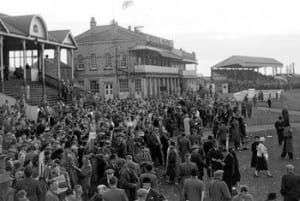The ‘Grandstand’ in Lincoln is the surviving part of the trio used by thousands every year to watch the Lincoln Handicap. This stand is actually called The Tattershall’s stand, the Grandstand lied 45 feet to the west of this, and The Silver Ring stand further westward. The audience would not know that two other stands used to be nearby, so our group will be reconstructing the plans of these stands out of horse hair twine. The idea for this reconstruction came from seeing how old photos and maps showed the size of the site when it was at it’s peak of operation.
This photograph shows the trio in full effect.
By presenting to the audience the de-constructed stands using archaeological techniques, they are able to relate more effectively than they could with a photograph. Mike Pearson states the use of archaeology ‘takes the remains of the past and makes something out of them in the present. A contemporary creative work’ (( Pearson, Mike (2010) Site-Specific Performance, Palgrave Macmillan:Basingstoke. p. 44)) . The literal remains of the past still remain as there is fencing and turnstiles still in place today that would have been used 60 years ago. As well as this foundations from the old stand can still be felt below the ground. The hope is that the audience can picture where the old stands were built and how the environment around them still holds evidence of the buildings.
Below is a video link of our first attempts to re-map the central Grandstand, although some measurements were inaccurate, we were able to get an idea of size and any obstacles that obstruct the plans since deconstruction.
